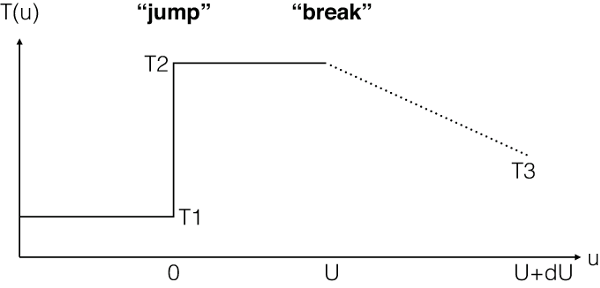4.1.30. Neij: non-equilibrium ionisation jump model¶
This model calculates the spectrum of a plasma in non-equilibrium ionisation (NEI). For more details about NEI calculations, see Non-equilibrium ionisation (NEI) calculations.
The present model calculates the spectrum of a collisional ionisation
equilibrium (CIE) plasma with uniform electron density
and temperature
, that is
instantaneously heated or cooled to a temperature
. It then
calculates the ionisation state and spectrum after a time
.
Obviously, if
becomes large the plasma tends to an equilibrium
plasma again at temperature
.
The ionisation history can be traced by defining an ionisation parameter,
with defined at the start of the shock.
By default the model describes a classical NEI condition with a flat temperature profile:
For the case the user wands to calculate more complex situations, SPEX
offers two modes to treat a temperature profile : analytic
expression (mode 1) or ascii-file input (mode 2).
The temperature profile in mode=1 (analytic case) is given by
By setting a non-zero value for , this model offers the
opportunity to calculate more complex evolution in the last epoch
(
); e.g. with secondary heating/cooling process and/or
change in density. We introduce parameters
and
, which describe a power-law like evolution respectively
for temperature and density of the plasma after the “break” of constancy
at time
:
(1)¶
An immediate application of this break feature would be a recombining
plasma due to rarefaction (adiabatic expansion). Such a condition can be
realised with and
. Note that we
include the effect of the density change here in the NEI calculation for
the ion concentration, but of course the line emission is calculated at
the density prescribed by the parameter ed of the model, which
represents the true density at the epoch of emission of the spectrum.

The temperature profile with mode=1.¶
To get the expression for , we first calculate the increase
of the ionisation parameter after
as follows:
(2)¶
Then, by combining equations (1) and (2), we obtain:
and we get the final temperature at to be
It should be noted that, for fixed values of and
, the temperature change after the break is determined by
the ratio
rather than
itself. The user can check
with the
ascdump plas command (see Ascdump: ascii output of plasma and spectral properties)
and also the histories of and
with the
ascdump nei command (see Ascdump: ascii output of plasma and spectral properties).
In some rare cases with a large negative ,
can
get an unphysical value (
). In such a case the
calculation will automatically be stopped at a lower-limit of
keV.
For mode 2, the user may enter an ascii-file with - and
-values. The format of this file is as follows: the first line
contains the number of data pairs (
,
). The next lines
contain the values of
(in the SPEX units of
s
) and
(in keV). Note that
is a requirement, all
should be positive, and
the array of
-values should be in ascending order. The pairs
(
,
) determine the ionisation history, starting from
(the pre-shock temperature), and the final (radiation)
temperature is the temperature of the last bin.
4.1.30.1. Plane-parallel shock mode¶
When a shock propagates through material, different layers behind the shock front are heated at different times, and therefore exhibit different ionization ages. As a result, the spectrum cannot be fully represented by a single neij component.
By setting mode = 3, the code approximates a plane-parallel shock. In practice,
this is done by dividing the ionization timescale parameter u into 200 logarithmically
spaced bins, starting from a minimal value near the shock front (set to )
up to the final
u specified as a model parameter. Each shell is given equal
weight, and the total ionization balance, and hence the resulting spectrum, is obtained
by summing over all shells.
A current limitation of the pshock mode is that it does not track the evolution of electron temperature behind the shock. Work is in progress on an improved version of the model that will include full energy balance considerations.
The parameters of the model are:
- t1:
Temperature
before the sudden change in temperature, in keV. Default: 0.002 keV.
- t2:
Temperature
after the sudden change in temperature, in keV. Default: 1 keV.
- u:
Ionization parameter
before the “break”, in
m
s. Default:
.
- du:
Ionization parameter
after the “break” in
s. Default value is 0 (no break).
- alfa:
Slope
of the
curve after the “break”. Default value is 0 (constant
).
- beta:
Slope
of the
curve after the “break”. Default value is 0 (constant
).
- mode:
Mode of the model. Mode=1: analytical case; mode=2:
read from a file. In the latter case, also the parameter
hisuneeds to be specified. Mode=3: plane-parallel shock. See description above.- hisu:
Filename with the
values. Only used when mode=2.
The following parameters are the same as for the cie-model (Cie: collisional ionisation equilibrium model):
- hden:
Hydrogen density in
- it:
Ion temperature in keV
- vrms:
RMS Velocity broadening in km/s (see Definition of the micro-turbulent velocity in SPEX)
- ref:
Reference element
- 01…30:
Abundances of H to Zn
- file:
Filename for the nonthermal electron distribution
Recommended citation: Kaastra & Jansen (1993).
